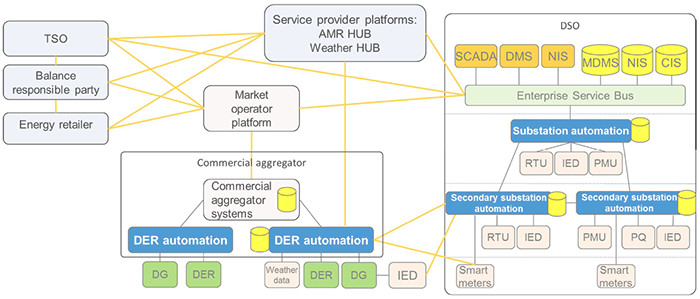“Ideal Grid for All” was the vision of a project collaboration between 13 European academic and industrial organisations – a vision that is now very close to becoming a reality as the project has ended with great results and eminent reviews from the
European Commission.Ideal Grid for All (IDE4L) was a project running from September 2013 to October 2016 that focused on developing distribution networks automation, IT systems, and functions for active network management to enable a system of clean and reliable energy for the future.
They worked from the insight that the operation of the existing distribution networks currently is challenged by integration of wind and solar power, heat pumps, electric vehicles, and other sustainable energy sources and energy saving functions.
The continuity of electricity supply is vital for the modern society and with a future network of more renewable energy. The network needs to be automated in handling more flexible demands, in order to uphold a reliable power system and energy market.
Therefore, the group behind the IDE4L project looked into the capacity of the networks and how to develop new integration techniques and automation techniques in order to integrate more renewable energy in the system. Their goal was to find the necessary techniques to increase the hosting capacity of the networks, not only by taking the renewable energy into account, but also the new and future demands such as electrical vehicles and heat pumps.
“Many have talked about - and are working on - finding answers for the future integration of renewable energy in distribution networks, but our concept is different from others and it works really well,” explains Associate Professor, Qiuwei Wu, Center for Electric Power and Energy, DTU Electrical Engineering.
Through a lot of hard work they developed architecture for both automation techniques and other new integration techniques that significantly improves the hosting capacity of the network. This architecture proved to be a framework that managed to make all the different elements and different techniques of the network work together automatically.

Graphic of the automation architecture of the IDE4L concept
A lot of hard - but thrilling - work
The automation framework was partly developed in the PowerLabDK facilities, where a lot of testing and development were performed. However, not all demonstrations were theoretically simulated. A lot of the necessary demonstrations were also performed in the real grid and distributed networks in Denmark, Spain, and Italy. Implemented in real power systems and tested in real life, the framework proved the concept of the IDE4L project by showing that with this technique a lot of future investments could be saved. The framework is based on new algorithms for the control and will therefore still work with the current hardware.
"The goals were achieved and the results are strongly supported by the demonstrations"
- Richard Hampton, Energy Commission
“The goals were achieved and the results are strongly supported by the demonstrations. The State of the Art has been clearly advanced for the integration and control of distributed energy resources,” states Richard Hampton in a Review Report on the behalf of the Energy Commission.
Through the time span of the project, the IDE4L group managed to develop a new planning and operation system for distribution networks by utilising flexibilities for distribution generation and intelligent devices to support the operation.
“The project got so far that it is very possible to take the techniques
and use them right away. The framework is estimated to increase the hosting capacity of
distributed energy resources in the distribution networks by up to 50
percent. The hard work of the partners paid off and we achieved
what we promised,” Qiuwei Wu says.
By automating the integration of renewable generation and energy efficiency appliances into distribution network management, the cost-efficiency of distribution networks will improve accordingly - thus ensuring more flow at lower cost, which makes an ideal grid for all.
An additional project on the way
The partners of IDE4L are planning to continue the collaboration in a new project. This new project will enforce a larger focus on the integration of different energy sectors for smart cities. Although IDE4L already includes heat pumps, it only considers the electric part. Whereas a new project will study the planning and integration of – as well as the interaction between – the different energy sectors such as the distributed electrical and heating systems, which will further improve the operation.